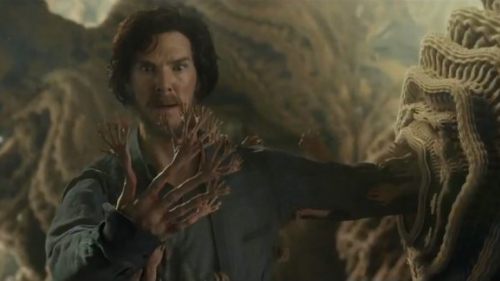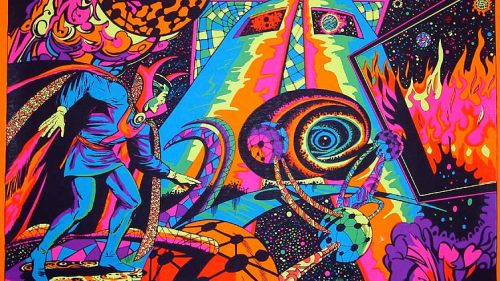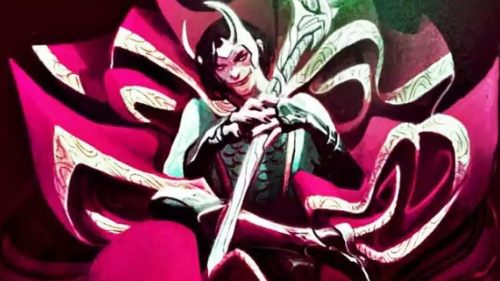DOCTOR STRANGE Review: Marvel Goes Mystic
The lore behind Doctor Strange is one of deep mysticism, elaborate and dense and not particularly easy to clarify in a two-hour film. The real spell here is that writers Jon Spaihts, C. Robert Cargill and director Scott Derrickson manage to do just that, taking this labyrinthine mythology and making it feel relevant and vibrant.
It’s a smart approach to the predicament of adapting a fantastical comic like Doctor Strange for the big screen, one that was made manifest in the very first trailer we saw for the film. Chiwetel Ejiofor’s Mordo takes a newly arrived Stephen Strange to his lodgings at Kamar-Taj, and hands Strange a scrap of parchment on which the mysterious word “Shamballa” is written. Strange sighs and asks if “Shamballa” is meant to be his mantra, and Mordo replies, “It’s the Wi-Fi password. We’re not savages.”
It’s a corny joke, one of dozens in Doctor Strange, but it’s a corniness that works perfectly with this somewhat corny character. The world of Stephen Strange is long removed from the worlds we’ve been introduced to so far by Marvel Studios – with the exception of Kenneth Branagh’s colorful take on Thor – and Doctor Strange makes a cheerful departure from the philosophy that comic book movies need to be grounded in realism. But alongside the ancient Eastern mysticism and dimensional puddle-jumping are matter-of-fact references to Beyoncé and Adele. Like Strange himself, Doctor Strange is tied to the past and present, a time-bending trick that makes the film feel both fresh and primal.
This tactic of old meets new is best represented in Doctor Strange’s sensational visual effects. The inter-dimensional sorcery of Strange’s world allows for a visual playground that ILM uses to its wildest potential. Greenwich Village buildings bend and twist and double into themselves, creating a galaxy of angles and fractals. Strange whips through a dimensional portal of prisms and pigments. The rainbow-saturated kaleidoscope onscreen would feel charmingly dated, as ‘70s-psychedelic as a Cream album cover, if not for the fact that it’s all an astonishing technological achievement. The 3D, a format that is almost entirely squandered in modern cinema, is remarkable. My eyes were dancing around the IMAX screen for fear of missing a single inch of the spectacle.
None of this - the clever, winking tone, a stunning optical pageant – would work without an effective story and characters. The story, well, you know it. It’s an origin story, complete with training montage and a reluctant hero. But Stephen Strange is unusual in that his reluctance doesn’t stem from lack of self-confidence but rather arrogant disinterest in anything other than himself. The film opens with a handsome, wealthy neurosurgeon shrugging off a past love affair with Rachel McAdams – this is hardly relatable stuff for most of the movie-going population.
But as Strange takes his journey from surgeon to sorcerer, he struggles with trials that are plenty relatable for many of us. Strange must learn to overcome his dogged self-sufficiency in order to trust in something greater than himself. He is forced to redefine who he is when the most essential part of himself is taken from him. And, above all, Strange has to learn that “it” isn’t about him. The multiverse at large, this fight to protect the planet from the encroaching Dark Dimension, even the car crash that mangled his hands and robbed him of a career he loved and at which he excelled – none of it is about him. It’s all part of a bigger whole, too big for Strange to see and far greater than he can control, even with his brilliant mind and immense capacity for power. The stronger Strange grows, the more he reads and researches, the further he sees into the deep mysteries of the multiverse, the more he learns that he still has so, so much to learn.
It’s quite a role, and Benedict Cumberbatch carries it admirably. There was never any question that the Sherlock actor could convincingly portray a character of genius and gravitas, so the pleasant surprise comes in during Strange’s moments of vulnerability and chumminess. There’s a rakish Indiana Jones-ness to Cumberbatch’s American accent, a jolly derring-do that feels right at home with his over-the-top goatee, amulet and cloak. The Cloak of Levitation is a bit of a cutesy sidekick for our dashing hero, a sentient thing that pulls and points Strange in the right direction and wipes his tears before he sets out to save the world. If it sounds corny, it is, but again – the corniness works.
Cumberbatch is far from the only heavy-hitter in this cast. Mads Mikkelsen is profoundly, magically weird as the villain Kaecilius, a character whose menace is doubled when we learn of his true motives. Chiwetel Ejiofor plays Mordo, a gifted instructor at Kamar-Taj, devoted to The Ancient One and the mystical arts but dangerously inflexible in his view of right and wrong. Benedict Wong is terrific as Wong, a character originally conceived as nothing more than Strange’s manservant but who is here a guardian of the knowledge of Kamar-Taj and something of a mentor to Strange. Wong feels like a bastion of goodness and wisdom, who also happens to deliver most of the laugh out loud moments in the film. And although Rachel McAdams’ Christine Palmer is a fairly typical love interest left behind in pursuit of the hero’s journey, she’s also a brilliant, empathetic doctor in a memorable (if paltry) role. Even the tertiary actors are strong, with Michael Stuhlbarg, Scott Adkins and Benjamin Bratt all popping up in surprising turns.
And then we have Tilda Swinton as The Ancient One, an example of positive gender-swapping that also falls prey to white-washing. Derrickson was in a tricky position with this character, founded on long-dated Asian stereotypes before the director even got his hands on it, but making The Ancient One a woman at least gave Doctor Strange a far more dynamic and interesting female character than Marvel movies typically offer. And of course Swinton is tremendous here, an unusual, commanding performance that signifies immeasurable time and power. When Strange first arrives at Kamar-Taj, he assumes The Ancient One is a tiny, withered old man with a silver goatee. There’s something to be said for his surprise, even dismay, when he discovers that he traveled across the world and spent his last dime to meet a bald, soft-spoken woman instead.
While there’s some heady subtext at play here, the emotional stakes of Doctor Strange lack any real staying power. Strange is such a distancing character that it’s difficult to care about his relationships with any of the people surrounding him, even his mentor, even his romance with a very likable Christine Palmer. The real crux of the narrative is Strange’s acceptance of his role as Master of the Mystic Arts, but of course that’s a foregone conclusion before the film even begins. There’s a far more compelling story to be told in Mordo’s crisis of faith in the philosophy to which he’s dedicated his life, but Doctor Strange spends very little time on that. Of course, Ejiofor will return in a bigger role in a likely sequel, but it’s too bad this film tosses away its most emotionally resonant arc to allow time for fight scenes and prodigious action set pieces.
That said, oh, this action is good. It’s visually engaging and, for all of the film’s freewheeling approach to the basic laws of physics, easy to follow. The fight scenes are fun, and what’s more, they’re responsible. Much of the destruction takes place in the Mirror Dimension, an early-established cheat that allows for some satisfying annihilation that doesn’t have any effect on the real world. We watch entire blocks being twisted and shattered, but with the knowledge that human casualties are at a minimum. The stakes are still terribly high, because the continued existence of our planet relies on Strange’s success, but thousands of people aren’t being killed, injured or made homeless in an indifferent clash of titans. That matters.
And it’s just one way that the multi-dimensional magic of Doctor Strange’s universe changes all the rules for superhero movies. It breaks from formula and leaves room for innovation and play. Now that we’ve got that pesky origin story out of the way, this is a world that can go anywhere.



